Many words in the printing world, such as pamphlets and brochures, can be confusing for a layman. They are often used interchangeably in everyday conversation. This is because the layouts for pamphlets and brochures are similar and share a common goal as marketing material. But if you look closer, you will spot the dissimilarities. So now let’s answer the pamphlet vs. brochure question in detail, along with the key differences.
To understand the difference, you first need to know what is a pamphlet and a brochure separately. This write-up is a complete guide for all your queries about both terms.
What is a pamphlet?
A pamphlet is a single sheet of paper that can have a bifold or trifold and is used to inform or educate its readers. They are informal, inexpensive and easy to print. Also known as leaflets, these are distributed in mass to create awareness about a single subject.
The purpose of the pamphlet is to give detailed information. They are not used to sell or advertise. Typically, pamphlets are used non-commercially, but you can use them to promote local businesses and create a brand identity as they are economical to print. It can either be inserted with the newspaper, dropped in the mailboxes, or distributed publicly on roads. Also known as flyers and handouts, pamphlets are called polyeto in Tagalog.
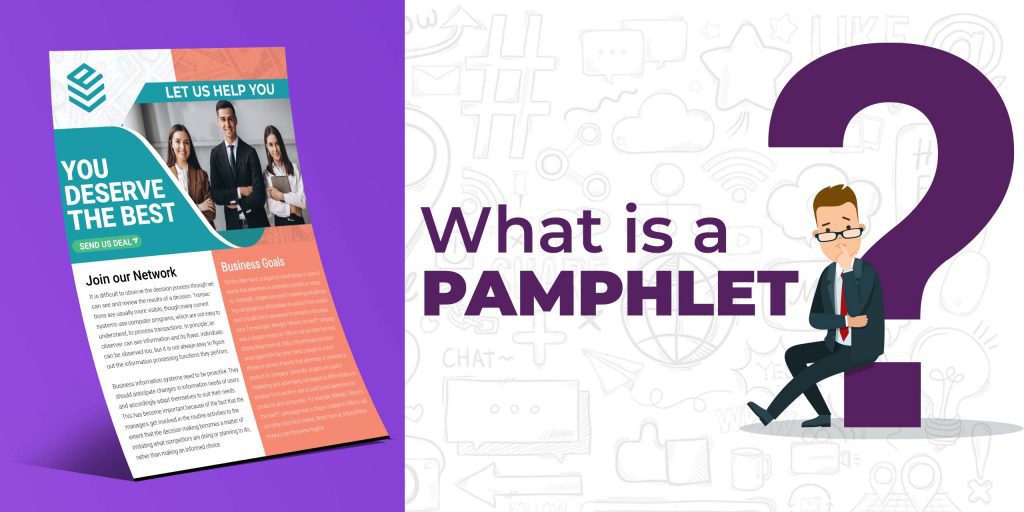
Let’s look at a few pamphlet examples to clarify the characteristics. You must have encountered them while visiting the hospital or talking with your doctor about a disease or procedure. Similarly, educational institutions can share course information. Pamphlets are also commonly used by political parties to share their manifesto during polls. A short printed item that makes any data easier to understand, pamphlets can also be in digital form for a wider reach.
Now that we have an idea about what is a pamphlet let us understand brochures in depth.
What is a brochure?
A brochure is a type of marketing material designed to enlighten patrons about the whole range of products and services offered by a company.
They are formal and modern ways of advertising. Also known as booklets, brochures typically contain detailed information with the intent to sell. It can take the form of a single sheet of paper folded in two, three, or multiple panels, or a bound booklet with several pages.
Designers usually print brochures with eye-catching layouts, high-resolution images, and good-quality glossy paper to enhance their appeal. If you wish to know brochure design in detail, read our detailed step-by-step guide on brochure design.
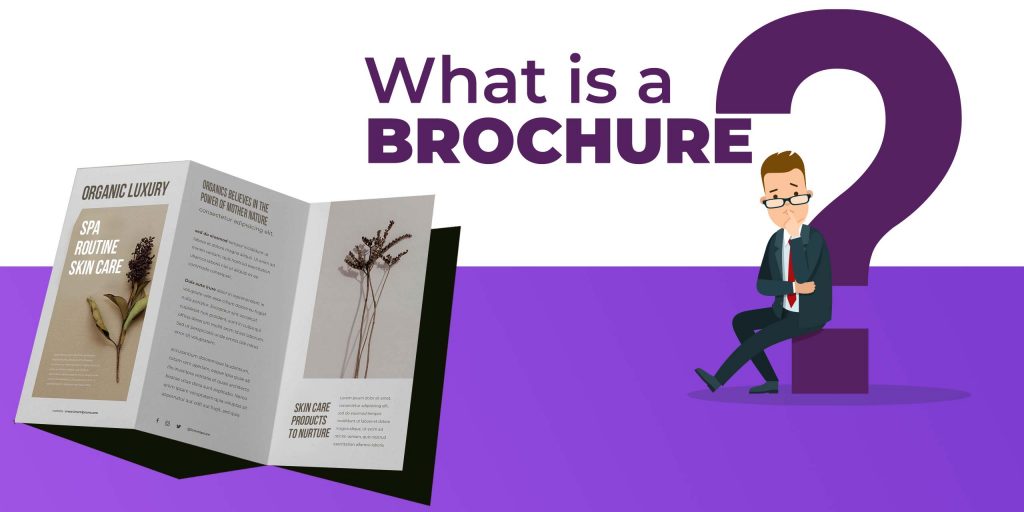
Marketers consider brochures an essential tool for promoting products, services, or events. They aim to showcase the organization’s products and services in an attractive way to promote the business. They are also a great way to introduce a brand to new customers and increase brand visibility.
Marketers use brochures as advertisements to promote events and share detailed information about them. The relevant images with engaging content make for easy bait to catch the audience’s attention.
Pamphlet vs Brochure – Key Differences
Both pamphlets and brochures are vital promotional tools for any business. Both have different goals and can use them according to the product, target audience and marketing strategy. Listed below are a few significant points that will help you understand pamphlet vs brochure differences in a better way.
- Printers typically produce pamphlets on a single sheet of paper, sometimes folding them once (bi-fold) or twice (tri-fold). In contrast, they create brochures as mini booklets, often binding them or adding multiple folds to include detailed content and images.
- Small businesses often use pamphlets to raise public awareness or as part of an advertising strategy. In contrast, companies use brochures primarily for promotion and direct selling.
- Pamphlets cover information on a single topic in detail, while brochures are a comprehensive analysis of the organization that covers all the products and services offered. It also has relevant pictures to make it look inviting.
- Pamphlets are cheap and easy to print, whereas brochures need more resources and planning.
- People usually distribute pamphlets along with newspapers or hand them out outside public places like theaters or stadiums. In contrast, businesses typically give brochures to attendees at large-scale events or conferences.
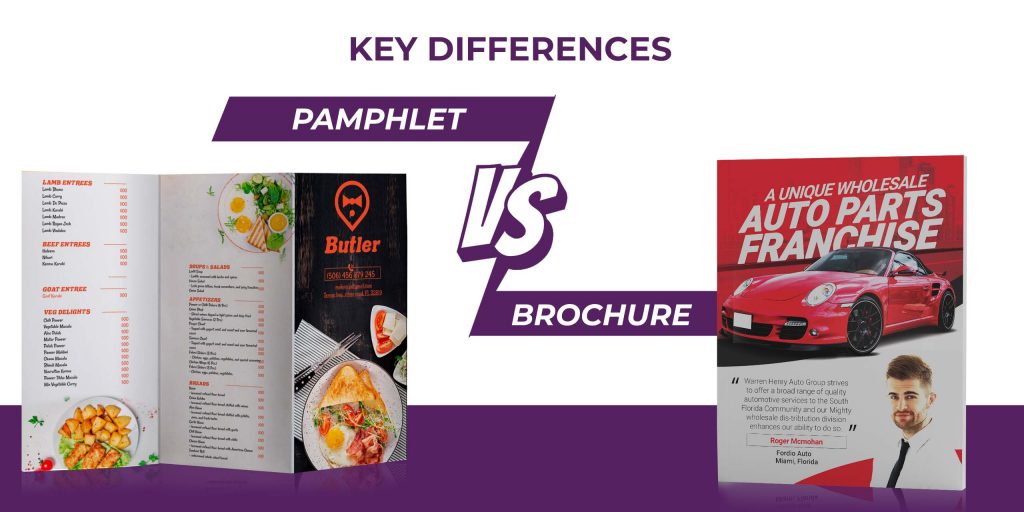
When planning your marketing strategy, you should have the right mix of pamphlets and brochures, as both help build brand recognition. In the next segment, we will focus on the various pamphlets and brochures you can create to present your company’s statistics.
Types of pamphlets and brochures formats
Both pamphlets and brochures have identical drafts, and the beauty is you can use any of them to your advantage to fulfill your company’s marketing goals. Listed below are the different types of pamphlets and brochures.
Gatefold Brochure & Pamphlet Template
A gatefold divides the paper into three parts, with the two outer panels folding inward to meet in the center. The left part is the front, and the right one is the back. A gatefold pamphlet caters to simple product descriptions. The standard size for this type of template is 8.5-x11”.

Trifold Brochure & Pamphlet Template
As the name suggests, a trifold divides a single sheet of paper equally into three sections. This template is suitable for displaying business details and services offered. It is a great printing option to showcase a mix of design and content. The standard size for this type of template should be 8.5”x11”.
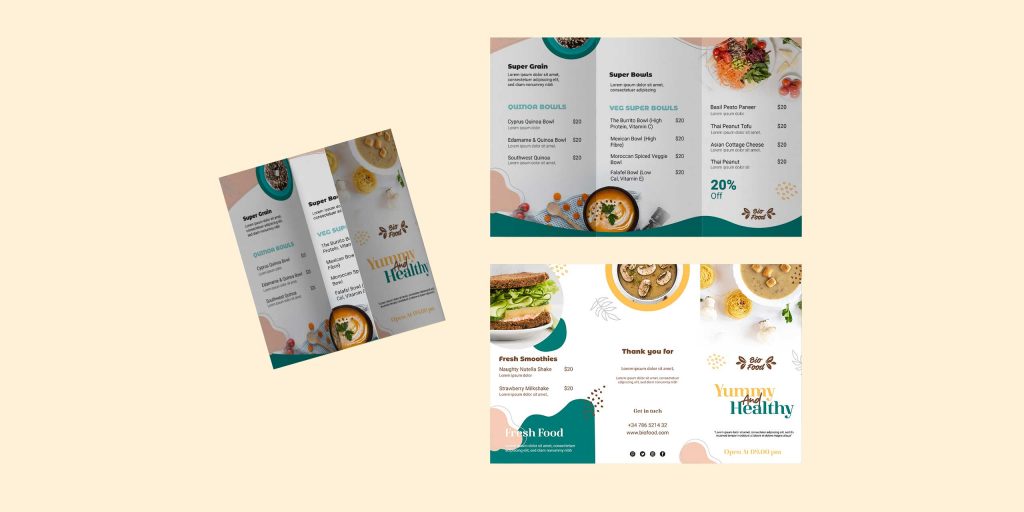
Z fold Brochure & Pamphlet Template
A befitting option for general descriptions Z fold has four folds and takes the shape of Z when opened. All the panels overlap each other. You can design Z fold in a single side or double side. The standard size of the template is 8.5”x11” in length and up to 24” in width.
Accordion fold Brochure & Pamphlet Template
In this format, the paper folds into four panels and opens up in shape of an accordion. This is suitable for providing step-by-step instructions. Accordion folds typically have a length of 8.5”x14”.
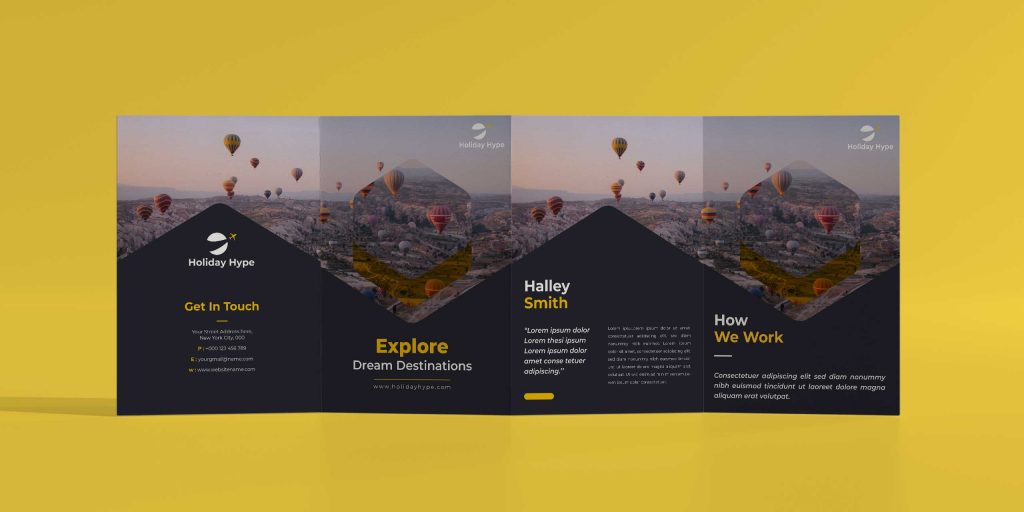
Bifold Brochure & Pamphlet Template
A bi-fold folds the paper in half. You will get four printable sides; Front, back, and two insides. It is an appropriate option for simple product descriptions or explaining a single subject. You can design this document as a single page or a multi-page booklet.
You can also include pockets inside a bi-fold brochure to insert your business card or other important information.

French bold fold Brochure & Pamphlet Template
Also known as the right angle fold, the french bold fold is applicable for both, pamphlets and brochure. In this, you fold the paper in half two times. The second time has to be perpendicular to the first. This is suitable mainly for travel brochures and event invitations. French bold folds have a standard length of 8.5”x14”.
You can decide on any of the templates mentioned above to advertise or promote your company, institution, shop, or organization. There are a few things to keep in mind.

- Generally, pamphlets or brochures have a standard length of 8.5”x11”.
- The front page will have the name, logo, and topic heading it aims to cover.
- The inside will have the message in detail.
- The back panel is for printing contact information or any call-to-action messages.
- For pamphlets, you can take any plain inexpensive paper, but for brochures, you should have high quality, preferably glossy paper, to get the most impact.
Once you have zeroed in on the template type, you need to work on the content and images. Read the following section for a step-by-step account of what a pamphlet or brochure should include.
How to design a pamphlet or brochure

- Know Your Purpose & Audience
Define the goal and who you’re speaking to. This ensures your message stays focused and relevant. - Research Thoroughly
Gather accurate info from credible sources to support your content. - Plan the Layout & Headline
Decide your structure early. Use a compelling headline—e.g., for real estate: “The High Life.” - Write Short, Clear Content
Use simple, impactful language. Keep sentences brief and easy to grasp. - Use Visuals Strategically
Add relevant, high-quality images, charts, or icons. Always test print quality. - Craft a Memorable Tagline
Think “Just Do It” (Nike) or “Eat Fresh” (Subway). Keep it catchy and brand-aligned. - Include Your Logo & Brand Name
Ensure your brand identity is visible and consistent across materials. - Avoid Common Design Mistakes
- Don’t clutter with excessive text.
- Leave white space to avoid visual overload.
- Proofread for typos and run test prints.
- Link to Extra Info
Use website or FAQ links if you have more to say, instead of overcrowding.
Conclusion
We hope this article has been helpful for you to understand what is a pamphlet and a brochure along with the key difference between pamphlets and brochures, i.e., pamphlet vs brochure. To summarize, pamphlets are ideal when you want to advertise or create awareness about a single topic, and brochures are practical for showcasing comprehensive information for marketing or advertisement.
Whatever you decide, you can always count on experts like Design Shifu for all your graphic design requirements. Not to forget, you can always pick from our subscription packages that best meet your needs and budget. What’s more, these subscriptions come with 24×7 support, unlimited revisions and a 100%, 14-day money-back guarantee!
FAQs
What is a brochure and how does it differ from a pamphlet?
A brochure is a structured, visually appealing printed material that provides detailed information about a product, service, or event. It is usually folded and presents information in an organized layout. While a pamphlet is more concise and informational, a brochure is designed to captivate the reader with its aesthetics and comprehensive content.
How are pamphlets typically used?
Pamphlets are frequently used to disseminate information about a cause, event, or service in a cost-effective and easily distributable format. They are commonly used in public awareness campaigns, healthcare initiatives, and community events to inform and engage a target audience.
What are some examples of pamphlets?
Examples of pamphlets include educational brochures on health topics, event invitations, informational leaflets about local services, and promotional materials for organizations or businesses.
How can a well-designed pamphlet benefit my marketing strategy?
A well-designed pamphlet can effectively grab the reader’s attention and convey important information quickly. It can help increase brand awareness, educate potential customers about your products or services, and generate interest, ultimately leading to higher engagement and potential sales.
How does a brochure enhance marketing efforts?
Brochures enhance marketing efforts by presenting a visually appealing, organized, and comprehensive view of a company’s offerings. They effectively communicate key messages, showcase products or services, and leave a lasting impression on potential customers, ultimately driving brand recognition and attracting business.
What’s the ideal length for a pamphlet or brochure?
The ideal length for a pamphlet or brochure varies based on the purpose and content. Generally, keeping it concise and informative is key. Aim for 1-3 pages for pamphlets and up to 6 panels for a folded brochure, ensuring the content is engaging and easy to read.

![What is a pamphlet? Pamphlet vs Brochure explained [With Examples]](https://designshifu.com/wp-content/uploads/2022/10/Cover-Image.jpg)